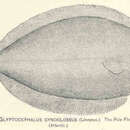Diagnostic Description
provided by FAO species catalogs
Body elongate, 2.5 to 3.5 times in standard length. Blister-like cavities on the underside of the head. Mout small, reaching anterior edge of lower eye. Lateral line straight; scales 110-140. First interhaemal spine projecting in front of anal fin, sometimes very small and hidden in the skin.. Dorsal finrays 95 to 120. Anal finrays 85 to 102. Pectoral fin of eyed side shorter than head. Colour brownish or greyish-brown; body and fins thickly speckled with minute black dots; median fins more or less dusky towards their margins, distal part of pectoral fin blackish.
Muus, B.J. & P. Dahlström. - 1971. Guia de los peces de mar. Pesca, Biología, Importancia económica. Ed. Omega, S.A. Barcelona. 259 pp.
Distribution
provided by FAO species catalogs
Eastern Atlantic, from northern Spain (Bay of Biscay) to northern Norway, also Iceland. Elsewhere, western Atlantic southwards to Cape Cod.
Size
provided by FAO species catalogs
To about 62 cm, seldom more than 35-40 cm.
Brief Summary
provided by FAO species catalogs
Benthic, on soft bottoms in fairly deep water,most often between 45 and 1460 m, predominant from 184 to 366 m deepand prefers temperatures of 2-6º C. Feeds mainly on crustaceans, worms and brittlestars. Spawns between May and September. Its growth is rather slow, sexual maturity is attained in 3 to 4 years, and the witch may live for 14 years.
Benefits
provided by FAO species catalogs
It is of some importance as a food-fish in northern European waters, especially off Iceland, Faroe, Norway, and Sweden. The total catch reported for this species to FAO for 1999 was 18 969 t. The countries with the largest catches were (4 148 t) and UK (3 661 t). Caught with bottom trawls. The most common fishing techniques are "demersal bottom trawling" and "small flatfish (flounders, soles) bottom trawling". Marketed fresh or frozen; eaten steamed, fried, microwaved and baked.

